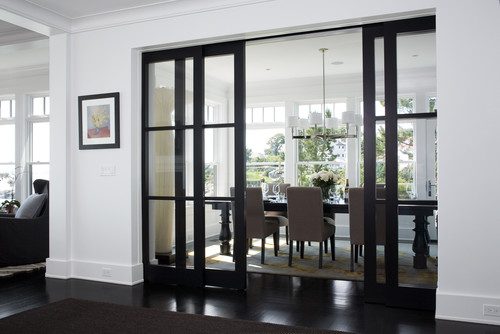Top 6 Home Design Trends To Watch in 2023
Over the past few years, many of us have spent extra time at home—and that means we appreciate the personal design touches that make a house cozy and comfortable more than ever. Some of us have adapted our dwellings in new ways, from creating functional home offices to upgrading the appliances we use most.
But while it’s important to make your home your own, it’s also smart to think about the long-term impact your renovations could have on its value. Choosing highly-personalized fixtures and finishes can make it harder for future homebuyers to envision themselves in the space. Even if you don’t plan to sell your home soon, investing in popular design choices that are likely to stand the test of time will make things easier down the road.
And if you’re in the market for a new home, it’s wise to keep an eye out for features that might need to be updated soon so you can factor renovation costs into your budget.
We’ve rounded up six trends that we think will influence interior design in 2023, as well as ideas for how you might incorporate them in your own home. Remember, before taking action, it’s always wise to consult with a real estate professional to understand how specific updates and upgrades will affect your property’s value in your local market.
1. Separate Kitchen, Dining and Living Areas
For years, home design has been dominated by open-concept floor plans, particularly for kitchen, dining, and living areas. However, as the pandemic forced families to work and study from home, many struggled to find the privacy and separation they needed. As a result, designers report that more families are choosing to bring back kitchen and dining room walls to break up the space and create quieter areas.1
That doesn’t mean that we’re returning to an era of dark and cramped spaces, however. Even as walls make a return, it’s important to take care to retain a sense of flow and openness within the home and to prioritize natural light.
If you’re buying or building a new home, consider how you will use the space and whether or not an open floor plan will suit your needs. If you already live in a home with an open floor plan and it isn’t working for you, try rearranging furniture and strategically placing pieces like bookshelves, room dividers, or rugs to create distinct areas within the home and reduce noise.
2. Nature-Inspired Design
In the past few years, we’ve seen the “biophilia” trend explode, and there are no signs that it will be any less popular in 2023.2 This trend is all about bringing the outside in by adding natural touches throughout your home.
This year, design experts predict that natural, sustainable materials like bamboo, cork, and live-edge wood will lend character without being overwhelming. Wooden kitchen cabinets and islands will become more common in 2023, with white oak and walnut among the most popular choices.3,4 Wood will also appear in bathroom vanities and shelving and furniture throughout the home.
Colors inspired by nature (think mossy greens and desert tones) will also play into this trend and will blend seamlessly with wood tones. We’re also seeing a return to natural stone countertop materials like quartzite, marble, dark leathered granite, and soapstone.4,5
If you’re planning to add new shelving or redo your kitchen, consider turning to these materials to embrace the biophilic look. Or, incorporate elements of the trend by choosing nature-inspired paint colors and adding to your houseplant collection.
3. Lighting as a Design Feature
Spending more time at home has shown us the importance of having the right lighting for specific tasks and times of the day. As a result, many homeowners are reconsidering the ways they light their homes and using light fixtures to change the usability and mood of their spaces.5
In particular, homeowners are rejecting bright, flat overhead lighting and replacing it with lamps and task-specific options. A layered approach to lighting—such as using a combination of under-cabinet, task, and ambient lighting in a kitchen—enables homeowners to tweak the level of light they’re using based on the time of day and what they are doing.
In 2023, we expect to see more statement chandeliers, pendants, and wall sconces in a variety of shapes and materials.6 Thinking about switching up the lighting in your home? Start by adding floor or table lamps and swapping out fixtures before you invest in rewiring your space. Take note of what works and what doesn’t and watch how the light in your home changes throughout the day. You can then use that information to make lighting decisions that require a bigger investment.
4. More Vibrant Color Palettes
After the long dominance of whites and grays, more vibrant colors are coming back as a way to add character and dimension to homes.
This year, warm and earthy neutrals, jewel tones, and shades of red and pink are particularly popular.7,8 If your style tends toward the subtle, consider options like light, calming greens, blues, and pastels.
Major paint brands have responded to these homeowner preferences with their newest releases. Benjamin Moore’s 2023 color of the year, Raspberry Blush, is a lively shade of pinkish coral, while Sherwin William is embracing warm neutrals with Redend Point, a blushing beige.9,10 Behr’s choice of the year, Blank Canvas, is a creamy off-white that's a warmer version of the stark whites that have been trending over the past few years.11
If you’re planning to put your home on the market soon, it’s better to play on the safer side and avoid extremely bold or bright color choices when it comes to paint or fixed finishes like tile and countertops. Instead, try incorporating pops of color through throw pillows, art, and accessories.
5. Curved Furniture and Architectural Accents
Goodbye, sharp corners. In 2023, arches and curves lend a sleek feel that draws on classical design and retro trends while remaining modern.5,8 Rounded corners feel more relaxed and natural than sharp edges, lending more of a sense of flow and comfort to a home.
If you want to incorporate the trend into your new build or remodeling plans, curved kitchen islands and bars and arched alcoves are all good options—or you can take it a step further with arched windows and doorways. You can also carry this trend through to your light fixtures by incorporating a bubble chandelier or globe pendants.
It’s easy to embrace this look without renovations, too. Look for a softer feel in furniture, with sofas, chairs, and tables that showcase curved edges. Or, break up your space with an arched folding screen and a circular rug.
6. Art Deco Revival
Art Deco, the architecture and design style that took hold in the 1920s and ’30s, is enjoying a resurgence.12
As a style, Art Deco is marked by bold geometry, textures, and colors, as well as an emphasis on art. But the 2023 interpretation of this style is likely to be a bit less splashy than its historical roots. Designers predict that instead of incorporating all of the elements of the style, which could feel overwhelming, homeowners will pick bursts of color or bold accessories to bring some whimsy to their space.
Keep an eye out for vintage mirrors, lamps, or vases that bring a touch of Art Deco glam to your home, or embrace bold colors and fabrics like velvet. Choose pillows and throw blankets in bright colors and geometric patterns to nod to the look without diving in all the way.
DESIGNED TO SELL
Are you thinking about remodeling or making significant design changes to your home? Wondering how those changes might impact your future resale value?
Buyer preferences vary significantly based on your home’s neighborhood and price range. We’re happy to share our insights on the upgrades that will make it easier (or more difficult!) to sell your home. Give us a call for a free consultation!
The above references an opinion and is for informational purposes only. It is not intended to be financial, legal, or tax advice. Consult the appropriate professionals for advice regarding your individual needs.
Sources:
- US News and World Report
- Architectural Digest
- Insider
- Houzz
- The Spruce - Design Trends 2023
- The Spruce - Lighting Trends 2023
- The Spruce - Color Trends 2023
- Good Housekeeping
- Benjamin Moore
- Sherwin Williams
- Behr
- The Spruce











